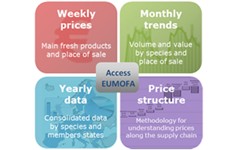 quaculture products.
quaculture products.The European Market Observatory for Fisheries and Aquaculture (EUMOFA) is a market intelligence tool that provides access to information on the sale and marketing of seafood, enabling users to analyze and determine the price at each stage of the supply chain.
The website is currently undergoing final amendments before going live, but a temporary website hosts a wide range of data on the first sale price at auction, on wholesale and retail prices, and on imports. Provided by FAO Globefish, DG MARE, EUROSTAT and DG TAXUD, as well as member states and private organizations, the data covers around 90 percent of EU catches and also includes information on aquaculture products. A spokesperson for EUMOFA told SeafoodSource that everything should be in full working order by the end of the month.
The aim of the website is to increase market transparency and efficiency, enable analysis of EU market dynamics, and support business decisions and policy-making. To make this possible, it hosts data from all EU countries, plus Norway and Iceland, as well as from European institutions.
This is the first time that all such data has been brought together in one place, in compatible format, and available in four different languages, English, French, German and Spanish.
The new tool is part of efforts by the commission to give European Producer Organizations (POs) greater information to help them develop a more market-oriented approach to landings and to “sell smarter” instead of being “price takers.”
It will for example enable POs to investigate at what times of the year a particular fish achieves the best price at auction, and to see what volumes are landed at which location. In turn it will aid the production of new marketing strategies to take full advantage of each situation, influence the market price, and consequently add value to local landings.
Robert Stevenson, CEO of the North East of Scotland Fishermen’s Organization, said that his PO has concerns about the quality of information available on the new site.
“It is useful as an historic reference site rather than as a real-time marketing tool, but it needs information from all member states to be uploaded, and definitely on a more regular basis,” he informed.
“There is also an issue with the data not being harmonized, although this is a long-term aim of the site, but it means that we are never sure if we are comparing like-for-like products.”
Development of the website is in line with the ongoing reform of the Common Market Organization (CMO) — itself a key part of the Common Fisheries Policy — and recognizes that marketing is the key social and economic driver of European fisheries.
The Commission’s proposal to reform the CMO, and with it, to change the role of the POs, notes that anticipation and management of market fluctuations is characterized by uncertainty, and that EU supply lacks predictability in terms of the volume and quality requested by buyers. It also refers to the fact that EU producers do not largely anticipate market demand in their production planning, which leads to a high volatility of first sale prices.
Fine details of the reform are still under discussion, but many POs have concerns about potential changes in their roles, which they are passing on to the commission through the European Association of Producer Organizations (EAPO).
Its president, Sean O’Donoghue, is pushing the commission hard to create a Markets Advisory Council (MAC), in the same way that Regional Advisory Councils were set up to enable stakeholders to advise on fishing policy.
“A MAC would be a vital means for the commission to gain stakeholder advice on reform of the CMO, and we are pleased that they are considering our proposal,” he advised.







